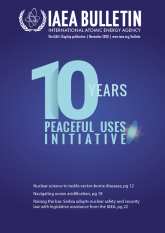In 1992, US scientist Edward Knipling and his colleague Raymond Bushland received the prestigious World Food Prize for their successful work in the 1950s developing the sterile insect technique (SIT), a method of controlling harmful insect pests through irradiation. In 2012, after years of study, planning and work, Senegal introduced the SIT — with support from the United States — in a coastal area of the Niayes region to eradicate the bloodsucking tsetse fly, known for killing cattle and causing human “sleeping sickness” (human African trypanosomosis). Senegal joined a growing list of countries making use of this nuclear technique.
For over four decades, the SIT has been an important joint effort between the Food and Agriculture Organization of the United Nations (FAO) and the IAEA. The SIT uses irradiation to sterilize male insects, which are then released into the wild to mate with females without producing offspring. Over time, this reduces insect populations that spread disease. The Joint FAO/IAEA Programme on Nuclear Techniques in Food and Agriculture invests in applied research to improve the technique and supports the rollout of SIT packages to IAEA Member States.
Before the campaign in Senegal, this programme successfully eradicated the tsetse fly from the island of Zanzibar in the United Republic of Tanzania and helped control the insect pest in the Southern Rift Valley of Ethiopia. In Senegal, the technique led to the eradication of 99 per cent of the targeted tsetse population in just six months. This enabled farmers to switch to more productive, non-disease resistant varieties of cattle, leading to increased meat and dairy output and providing a more secure livelihood for farmers. This is just one example of a programme through which the IAEA makes an enormous and cost-effective contribution to peace and prosperity worldwide.
Accelerating and enlarging the contribution of nuclear energy, science and technology to peace, health and prosperity has always been the driving mission of the IAEA, as set forth in its founding Statute in 1957, and as reinforced in Article IV of the Treaty on the Non-Proliferation of Nuclear Weapons (NPT) in 1970. The peaceful uses of nuclear science and technology hold answers for key challenges in sustainable development and provide excellent return-on-investment for the countries funding and implementing peaceful uses projects. However, the areas of great need that would benefit from peaceful uses cooperation and assistance far exceed the funding available to the IAEA through Member State contributions.



